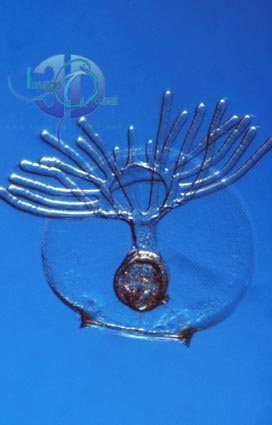|
Brachiopod Larva
©
2000 by Image Quest 3-D
Read our copyright notice
Photograph by Peter Parks Commenly known as Lamp Shells, Brachiopods (Phylum Brachiopoda) are an ancient group of animals that once dominated shallow Palaeozoic and Mesozoic seas, but declined after the Jurassic, possibly displaced by the radiation of the bivalves. Todays, worldwide fauna of about 300 species is tiny compared to the thousands of extinct species. Brachiopods are sessile animals with hinged, two-piece shells which are often confused with those of bivalves. However, brachiopod shells are always inequivalve, with a large ventral valve and a small dorsal valve, and attach to the seafloor by a fleshy stalk, a pedicle. All brachiopods filter feed using a tentaculate structure called a lophophore. Cilia on the tentacles create an incurrent water flow from which the animal filters fine organic particles. Sexes are seperate and fertilisation is external producing eggs that hatch into planktonic larvae, such as the example seen here. In this larval stage you can clearly see the circular, hinged valves with the soft parts developing within; notice also the developing lophophore structure protruding from the valves. Click here to view the 'Picture of
the Week' archive.
|
||||||||
|
|
||||||||


